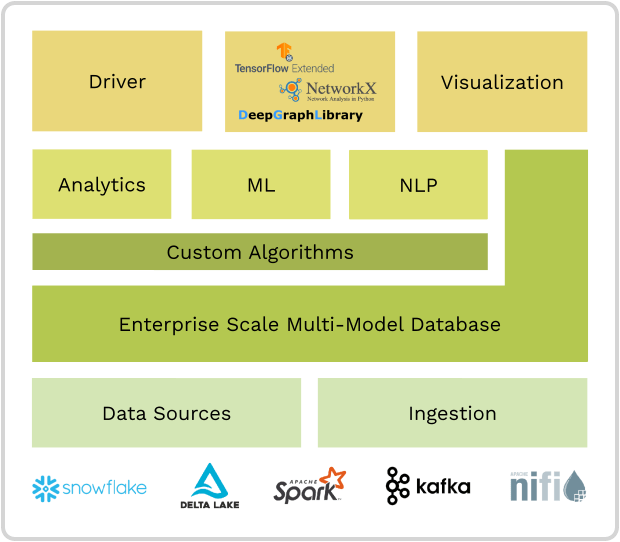ArangoDB Use Cases
ArangoDB is a database system with a large solution space because it combines graphs, documents, key-value, search engine, and machine learning all in one
ArangoDB as a Graph DatabasePermalink
ArangoDB as a graph database is a great fit for use cases like fraud detection, knowledge graphs, recommendation engines, identity and access management, network and IT operations, social media management, traffic management, and many more.
Fraud DetectionPermalink
![]()
Uncover illegal activities by discovering difficult-to-detect patterns. ArangoDB lets you look beyond individual data points in disparate data sources, allowing you to integrate and harmonize data to analyze activities and relationships all together, for a broader view of connection patterns, to detect complex fraudulent behavior such as fraud rings.
Recommendation EnginePermalink
![]()
Suggest products, services, and information to users based on data relationships. For example, you can use ArangoDB together with PyTorch Geometric to build a movie recommendation system, by analyzing the movies users watched and then predicting links between the two with a graph neural network (GNN).
Network ManagementPermalink
![]()
Reduce downtime by connecting and visualizing network, infrastructure, and code. Network devices and how they interconnect can naturally be modeled as a graph. Traversal algorithms let you explore the routes between different nodes, with the option to stop at subnet boundaries or to take things like the connection bandwidth into account when path-finding.
Customer 360Permalink
![]()
Gain a complete understanding of your customers by integrating multiple data sources and code. ArangoDB can act as the platform to merge and consolidate information in any shape, with the added ability to link related records and to track data origins using graph features.
Identity and Access ManagementPermalink
![]()
Increase security and compliance by managing data access based on role and position. You can map out an organization chart as a graph and use ArangoDB to determine who is authorized to see which information. Put ArangoDB’s graph capabilities to work to implement access control lists and permission inheritance.
Supply ChainPermalink
![]()
Speed shipments by monitoring and optimizing the flow of goods through a supply chain. You can represent your inventory, supplier, and delivery information as a graph to understand what the possible sources of delays and disruptions are.
ArangoDB as a Document DatabasePermalink
ArangoDB can be used as the backend for heterogeneous content management, e-commerce systems, Internet of Things applications, and more generally as a persistence layer for a broad range of services that benefit from an agile and scalable data store.
Content ManagementPermalink
Store information of any kind without upfront schema declaration. ArangoDB is schema-free, storing every data record as a self-contained document, allowing you to manage heterogeneous content with ease. Build the next (headless) content management system on top of ArangoDB.
E-Commerce SystemsPermalink
ArangoDB combines data modeling freedom with strong consistency and resilience features to power online shops and ordering systems. Handle product catalog data with ease using any combination of free text and structured data, and process checkouts with the necessary transactional guarantees.
Internet of ThingsPermalink
Collect sensor readings and other IoT data in ArangoDB for a single view of everything. Store all data points in the same system that also lets you run aggregation queries using sliding windows for efficient data analysis.
ArangoDB as a Key-Value DatabasePermalink
Key-value stores are the simplest kind of database systems. Each record is stored as a block of data under a key that uniquely identifies the record. The data is opaque, which means the system doesn’t know anything about the contained information, it simply stores it and can retrieve it for you via the identifiers.
This paradigm is used at the heart of ArangoDB and allows it to scale well,
but without the limitations of a pure key-value store. Every document has a
_key attribute, which is either user-provided or automatically generated.
You can create additional indexes and work with subsets of attributes as
needed, requiring the system to be aware of the stored data structures.
While ArangoDB can store binary data, it is not designed for binary large objects (BLOBs) and works best with small to medium-sized JSON objects.
For more information about how ArangoDB persists data, see Storage Engine.
ArangoDB as a Search EnginePermalink
ArangoDB has a natively integrated search engine for a broad range of information retrieval needs. It is powered by inverted indexes and can index full-text, GeoJSON, as well as arbitrary JSON data. It supports various kinds of search patterns (tokens, phrases, wildcard, fuzzy, geo-spatial, etc.) and it can rank results by relevance and similarity using popular scoring algorithms.
It also features natural language processing (NLP) capabilities and can classify or find similar terms using word embedding models.
For more information about the search engine, see ArangoSearch.
ArangoDB for Machine LearningPermalink
You can use ArangoDB as the foundation for machine learning based on graphs at enterprise scale. You can use it as a metadata store for model training parameters, run analytical algorithms in the database, or serve operative queries using data that you computed.
ArangoDB integrates well into existing data infrastructures and provides connectors for popular machine learning frameworks and data processing ecosystems.


